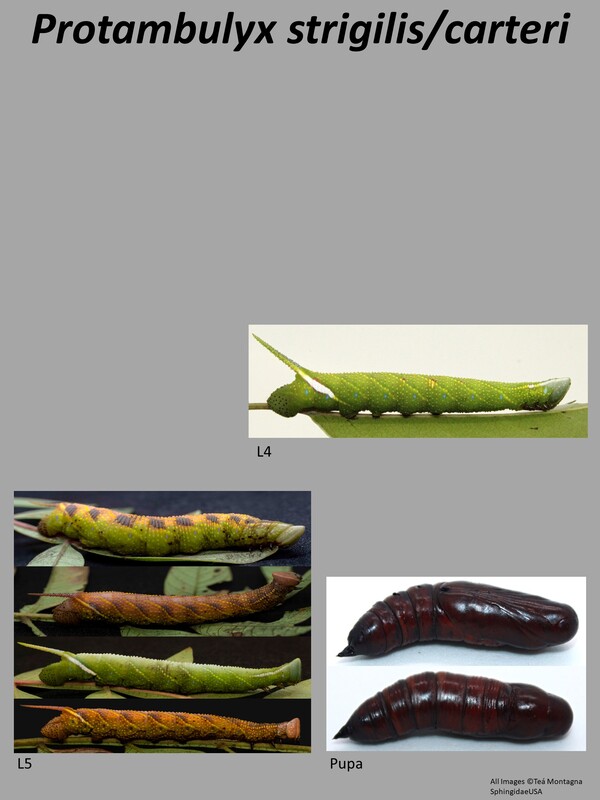|
NOTE: This species cannot be separated from Protambulyx carteri without DNA barcoding or genitalic dissection.
See COMPLEX page for more information. Common Name(s): Streaked Sphinx
Ecology and Life History Overview: This moth has a very large distribution, essentially from Southern South America all the way north to South Florida and The Caribbean. In Florida, this moth may actually be starting to move northward due to the spread of the invasive Brazilian Peppertree (1, 2). The northernmost records for this species are in Gainesville and St. Augustine Florida(1). The larvae feed on plants in the Anacardiaceae (Cashew Family). There is a lot of confusion regarding this species, and a similar species, Protambulyx carteri (2, 10). In 2007, through rearing, Tuttle synonymized the two species (2). In 2008, another paper was published that undid the synonymization (15). While P. carteri is currently considered valid in its usage, this page will contain P. carteri records and information as well as for P. strigilis. As more information comes to light, and better ways to separate these two species is found, this page will be updated. Habitat and Searching for Larvae: This moth can be found in most habitats. In Florida, there are records from cities, town parks, the Everglades, and assorted coastal areas (1). Due to the abundance of Brazilian Peppertree in Florida, this moth has become significantly more widespread in the state (1, 2). In fact, most images of larvae from the US have been in this tree. Larvae are fairly easy to find as they rest on the plants during the day. They also brightly fluoresce under UV light. Rearing Notes: Larvae are easy to rear in captivity. They do not mind being fed cut food, and don’t appear to be cannibalistic in later instars (1). Larvae can also easily be sleeved on plants (2). Larvae can be reared in plastic containers or screen cages. Pupation is easy to induce if you give the larvae several layers of paper towel on top of a slightly damp paper towel (1). The resulting pupae will emerge in 3-6 weeks (1,2) depending on temperature, and are quite sensitive to temperature fluctuation. Too much fluctuation and the adults will not expand their wings properly (1). Adult description: Adults are medium sized sphingids with forewings 48-55mm in length (2). This moth has the characteristic Smerinthinae look when at rest. The inner margin of the forewing bending slightly, making the forewings narrower toward the body and thicker toward the apex. The maculations of the forewings in this species are varied. The forewing is usually yellow-brown but can also be rusty orange, or some combination of those shades. Forewing maculation varies significantly with some individuals having many black markings on the wing, and some lacking that entirely. The hindwings are also fairly variable with some being more red, others being orange, and some being almost golden. There is a similar amount of maculation variation on the hindwings, though there are usually at least 2 faint black lines. Previously, Protambulyx carteri was the name used for moths that were generally darker, lacked a submarginal line on the dorsal and ventral surfaces, had minimal maculations on the ventral side of the forewings, and had a darker outer margin on the ventral side (10). Protambulyx strigilis was the name used for moths that were often lighter in coloration, have heavily maculated forewings (both dorsally and ventrally), a very distinctive subterminal line (both dorsally and ventrally), and a pale outer margin on the ventral side of the forewings (10). |
Larval description:
L4: Larvae are very smerinthine like. They are usually green and granulose with several cream/white faded abdominal streaks across each segment. The last abdominal streak is quite thick and large and ends at the caudal horn. In this instar, the caudal horn can be green, green-yellow, or blue and generally sticks straight upward. The horn itself is also granulose in appearance. The head capsule is blue-green or green and there are parallel white streaks that seem to spill over onto the first few thoracic segments. L5: In the final instar, larvae are not much different than in L4. The larger granulose larvae are still usually green, however there are other color morphs including a blue form, a maculated form (with purple/yellow maculations on it, mostly restricted to the dorsal region, but can cover the larva), and rarely an orange form. The abdominal streaks are still mostly faded and either white, cream, or yellow. The larger last streak is generally white, but in the other color forms it may also be cream or yellow. In the final instar, the horn becomes much more characteristic of the Smerinthinae, and is thicker, quite granulose, and sticks straight backward. The color varies from green to green-blue or green-yellow in most forms, some of the other color morphs may have an entirely yellow, orange-yellow, or orange-red horn. The head capsule remains the same with the two parallel lines, however the color of the head capsule matches the ground color of the larva. Host plants: Click here to load this Caspio Cloud Database
Cloud Database by Caspio |
The gallery to the left contains photos of Protambulyx strigilis adults. The data for each photo can be found by clicking on it. If you have a photo that you would like to submit to us, please contact us.
The gallery to the right contains photos of Protambulyx strigilis larval and pupal stages. The data for each photo can be found by clicking on it. If you have a photo that you would like to submit to us, please contact us.
The gallery to the right contains photos of Protambulyx strigilis larval and pupal stages. The data for each photo can be found by clicking on it. If you have a photo that you would like to submit to us, please contact us.


